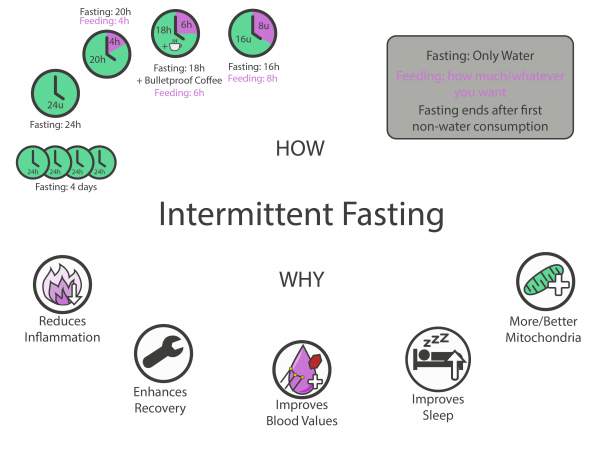My two-day fasting experience
I read the chapter about Dominic D'agostino in Tim Ferris' book 'Tools of Titans'. D'agostino is an associate professor in the Department of Molecular Pharmacology and Physiology at the University of South Florida Morsani College of Medicine, and a senior research scientist at the Institute for Human and Machine Cognition. He appeared twice on Tim Ferris' podcast and I can advise you to listen to both of them. The chapter describes the benefits of a 3 days fast once per month and a 5-7 day fast once per quarter. The goal is to reset your immune system and repair damaged cells. Before diving in, I wanted to test what it would be like not eating for day's. So I started with a two-day fast.
What is Intermittent Fasting?
Intermittent fasting means not consuming anything but water for a period of time, followed by a period of resuming normal eating habits. Depending on desired outcomes of the fast and the preference of the individual, feeding and fasting times can vary from 8 hours fast and 16 hours feeding period to fasting for several days, followed by a normal feeding for several days. During the feeding period, you can eat what you like and as much as you like, according to your normal eating pattern. The purpose of intermittent fasting is not to reduce the amount of food consumed, but to harness the positive effects of fasting on the body. So instead eat the amount of calories you would normally eat, but in a smaller time window instead of all throughout the day.
For a proper fast, only water may be consumed. This is because anything that requires active digestion or absorption will activate digestive pathways in the body, thereby turning the body back into digestion mode. Consumption of tea or coffee likely qualifies as non-water drinks, since these beverages contain nutrients that require active uptake and digestion.
The benefits of Intermittent Fasting?
Briefly, Intermittent Fasting has the following benefits:
- Promotes repair
- Reduces chronic low-grade inflammation
- Improves blood lipid and glucose levels
- Improves sleep
- Improves mitochondria
By not eating or drinking anything but water, the body can go into a repair mode. During periods of feeding, the body is working on breaking down food products into nutrients and incorporating them into existing cells and nutrient stores. During digestion, cells may be damaged due to the removal of waste and toxins or simply as a result of normal physiological processes. However, repair mechanisms only become active when no digestion takes place, and no new energy is taken up. This is one reason why sleep is restorative and healing because you are fasting for a 6-8 hour period.
During a fast, the body calls upon sources of energy stored within the body, such as fat depots in adipose tissue and glycogen stores in the liver. Damaged cell proteins and structures are among the first to be broken down and recycled to free up its component parts. By getting rid of waste and repairing damage, the body as a whole becomes more efficient. This process is called autophagy: the natural, regulated, destructive mechanism of the cell that disassembles unnecessary or dysfunctional components.
The mitochondria are the energy producing cell structures. By fasting, damaged mitochondria are repaired or recycled, making energy production more efficient, which reduces the creation of damaging reactive oxygen species (ROS). So by repairing your mitochondria, you will reduce any future damage they might cause through decreasing ROS production.
By removing waste, repairing damage and preventing more damage, overall low-grade inflammation may be reduced. Since long-term inflammation is linked to reduced life span and is likely involved in a lot of aging related diseases, such as cardiovascular diseases and cancer, Intermittent Fasting could be a useful tool to increase a healthy lifespan and quality of life in general.
There is evidence that suggests that fasts of 3 days or longer can effectively 'reboot' your immune system via stem cell based regenerations. D'Agostino promotes the idea of a 'purge fast': 'if you don't have cancer and you do a therapeutic fast 1 to 3 times per year, you could purge any precancerous cells that may be living in your body' (source: Tools of Titans)
The figure below describes the process of autophagy.
- When fasting for a prolonged period of time or severely restricting protein intake, the cell starts to activate autophagy (self-eating).
- Autophagy is the process by which cells digest and recycle parts of themselves, starting with damaged, dysfunctional and unused parts. Occasional damage to cells and cell structures is part of life. For instance, mitochondria get damaged over time as a side-effect of creating energy. Damage accumulates in a fed state, but is repaired in the fasted state.
- Mitochondria and damaged cell structures are wrapped in digestive vesicles and reduced to their component parts.
- When digestion is completed, free amino acids, fatty acids and carbohydrates are released into the cell.
- The cell uses the recycled resources to repair damage and create brand-new cell structures and mitochondria.

Process of autophagy explained - Design by Dagmar Bouwer for LiveHelfi.com
Types of Intermittent Fasting
Several time intervals can be chosen for intermittent fasting, depending on personal preference and goals. In general, the longer the fasting interval, the more effective repair and restoration pathways become. For that reason, fasting for 24 hours in a row will yield better results than two fasting intervals of 12 hours in two days.
Some Intermittent Fasting intervals are:
- 12 hour feeding/12 hour fasting
- 8-hour feeding/ 16-hour fasting
- 24-hour fasting
- 48-hour fasting
Remember: longer fasting periods promote more efficient repair and restoration. However, during a prolonged fast (several days) the body will rely mainly on fat stores and ketogenesis to supply energy and overall energy production and consumption will go down so that you might have less energy for high-intensity activities.

Intermittent fasting: How & Why - Design by Dagmar Bouwer for LiveHelfi.com
Is Bulletproof intermittent fasting real fasting?
Bulletproof Intermittent Fasting allows you to drink Bulletproof Coffee in the morning (with grass-fed butter and MCT Oil). The idea is that you consume only fat and stay this way in a fat burning mode. This provides restorative benefits, but not all repair pathways active in fasting will be available. That is why many experts say that a fast should be a real fast: consume nothing but water. Bulletproof intermittent fasting is my normal regiment because it provides me with a lot of energy to give me a kick start in the morning. It is also an easy way to follow a high-fat-low carb diet.
Bulletproof Intermittent Fasting is ideally combined with a protein fast once a week. By limiting protein intake only for 24 hours or more, the body will scavenge and recycle damaged proteins and other cell structures to acquire amino acids (autophagy). Protein fasting will thereby activate some repair mechanisms activated by fasting. So Bulletproof Intermittent Fasting combined with protein fasting will give you some benefits but the question is whether it will give you all the benefits of a real fast.
My two-day fasting
Sunday evening I had my last meal. Next morning my weight was 96,3 kg (it is has been around 95 kg for years). But thanks to all feasting days I gained some fat lately. I only had a cup of coffee. I know that it is not the same as water, but giving up my coffee was too much. I didn't add any fat to it and I didn't consume my daily dose of supplements. The rest of the day I just consumed water. I used a Ketonix to measure my ketones. I started Monday with a level of 7.9 PPM. The end of the day I measured 8.1. It means that the ketone level was quite constant.
During the day I felt pretty ok. The worst moment was 6pm. That is the time that I normally fuel my body with a huge meal. I decided to go for a round of golf instead. It appeared to be a very good way to avoid thoughts about food.
I went to bed at 10 pm. Sleep was perfect. My Sleepcycle App showed a 100% score. My Oura Ring showed a sleep score of 88% and a readiness of 87%. The score of my heart rate variability was the best ever.
I started day two with a ketone measurement of 7.0 PPM and ended the day with the same amount. The seconde day was quite the same as the first day. It was quite easy during the day, and around 6 pm my body was craving for food. I ended my 48 hours fasting period with a huge meal of Thai food!
Conclusion
The experiment was a success. I experienced no energy dips or other discomforts other than the appetite at the end of the first day. Three days later my weight is still 2 kg less than before I started fasting. I did feel some extra tension in my body. I can imagine that it is not a good idea to fast for a long period if you have a lot of stress and/or suffer from anxiety. Fasting stresses your body and you shouldn't challenge yourself too much. Now I am ready for a 4 or 5-day fasting experiment.
Two friends joined me in this experiment. We created a Fasting Heroes app group to share our experiences throughout the 48 hours. That was encouraging and fun! By the way, both friends are eager to join me for the 4 or 5-day fasting experiment. Are you interested? Tell me!












